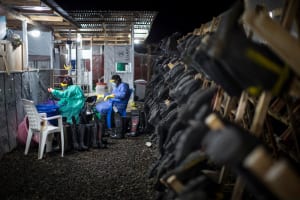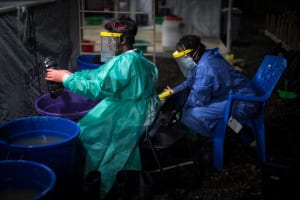Mañana jueves
DIRECTV estrena Unseen Enemy,
documental que revisa las epidemias del Siglo XXI
Unseen Enemy es narrado por el actor Jeffrey Wright (ganador de un Emmy y un Globe Award) y escrita y dirigida por la directora Janet Tobias.
El documental hace un seguimiento por más de tres años a médicos y patólogos que tratan los brotes de las epidemias del siglo XXI; Ébola, Zika e Influenza, donde doctores e investigadores explican cómo enfrentan estas enfermedades para salvar la vida de las personas.
 El documental muestra que todo en el planeta está interconectado. El crecimiento de la población, la mega urbanización, el cambio climático y la migración de las personas han incrementado el riesgo de enfermedades, las que ahora expandirse más rápido.
El documental muestra que todo en el planeta está interconectado. El crecimiento de la población, la mega urbanización, el cambio climático y la migración de las personas han incrementado el riesgo de enfermedades, las que ahora expandirse más rápido. Unseen Enemy muestra el desarrollo de la epidemia de Ébola en África, con los consiguientes costos económicos, la histeria medial por la enfermedad, la pobre respuesta internacional y cómo la inequidad empuja las epidemias.
También revisa la historia de las pandemias de influenza, una enfermedad que los médicos temen particularmente, ya que cada año en promedio puede matar entre 250 mil 500 mil personas en el mundo, y cada año nuevas cepas del virus – por su facilidad para mutar- emergen.
 Finalmente en Brasil, el documental muestra como el Zika ataca particularmente a un grupo de la población: las mujeres embarazadas y los niños. Y cómo el cambio climático y los viajes pueden influir en la expansión de enfermedades.
Finalmente en Brasil, el documental muestra como el Zika ataca particularmente a un grupo de la población: las mujeres embarazadas y los niños. Y cómo el cambio climático y los viajes pueden influir en la expansión de enfermedades.Estas epidemias dejan en claro que la sociedad moderna no está preparada para grandes pandemias. Como individuos estamos conectados con miles de otras personas diariamente y cada uno de nosotros está vinculado una red global que rápidamente nos conecta con personas que pueden estar en cualquier parte del planeta, algo que puede ser increíblemente beneficioso en muchos aspectos, pero también potencialmente peligroso.
Jueves 6 de abril. 21:00 hrs. en Argentina, Chile, Colombia, Ecuador, Perú y Uruguay y a las
22:00 hrs. en Venezuela.
Información de programación:
OnDIRECTV SD (Canal 201)
OnDIRECTV HD (Canal 1201)
SHORT SYNOPSIS
In the 21st century, we are all connected. Population growth, mass urbanization, deforestation, climate change and increased travel have dramatically increased the risk that familiar diseases will spread and mutate, and new ones will emerge. As people enter new spheres of biodiversity, they come in closer contact with other species, increasing the risk of viruses jumping from animals to humans, and then spreading more widely.
Unseen Enemy addresses why in the 21st century we are experiencing a rash of diseases that were once only outbreaks but have now become full-blown epidemics. This increased risk that we face is explained through the cases studies of three current epidemics interwoven in the film: Ebola, Influenza, and Zika.
Moving across the globe, we meet our characters: doctors, disease detectives, everyday men and women. Every one of them has stepped into the horror of an epidemic and emerged deeply changed. Epidemics bring out the best and worst of human behavior, and their effect goes far beyond the terrible tolls of sickness and death.
On the ground during the Ebola epidemic in West Africa, we witness the human and economic costs of epidemics, the global hysteria, the poor international response, and how global inequity drives epidemics.
Examining our yearly Influenza epidemics as well as the history of influenza pandemics, we learn that influenza is a disease experts particularly fear. Yet, influenza is often misunderstood by the public. Even in an average year, influenza can kill between 250,000 and 500,000 people globally. And new strains of Influenza are constantly emerging.
Finally, through the Zika outbreak in Brazil, we see how a disease can move across the world, endangering a particularly vulnerable target: pregnant women and infants. And we learn how climate change and travel can affect the spread of disease.
What these epidemics have made clear is that we, as a society, are woefully unprepared for a major pandemic. Dr. Larry Brilliant puts it this way: two speeding trains are racing toward each other, both fueled by modernity; one represents the increasing likelihood of a pandemic brought upon us by our own behavior; the other carries new tools and technologies that could help us find viruses and bacteria early enough to prevent a global outbreak. The choice is ours as to which of those speeding trains wins.
As individuals, we connect with thousands of other people every day; people we know well and others whom we only meet once. Each person is a part of a global web of connection that quickly leads from Vancouver to Hong Kong, New York to Liberia, Leipzig to New Delhi, Rio de Janeiro to Kinshasa, DRC. Our connection is either incredibly dangerous or a powerful force for good. Now more than ever, we need to put the ‘public’ back in Public Health: it is only by uniting our strengths that we will all be truly safe. It turns out we are all the frontline in global health.
![]()



